|
|
ARGENTINA/ARGENTUM/PLATA/COPA DE JOSE/BENJAMIN/SANTO GRIAL
AL PAN PAN Y AL VINO TORO
SILVER/PLATA
ARGENTINA/ARGENTUM/PLATA
LA CONSTELACION DE LAS PLEYADES ESTA UBICADO EN TAURO/TORO
|
|
Silver and Golden cross in the Coat of Arms of the Vatican
|
The Golden Gate is the ecliptic Milky Way crossing at the Scorpio-Sagittarius nexus on the zodiac while the Silver Gate is the Milky Way ecliptic crossing at the Gemini-Taurus nexus. The Silver Gate was represented by the horns of Isis and the associated bull Taurus.
9. Génesis 44:4: Habiendo ellos salido de la ciudad, de la que aún no se habían alejado, dijo José a su mayordomo: Levántate y sigue a esos hombres; y cuando los alcances, diles: ¿Por qué habéis vuelto mal por bien? ¿Por qué habéis robado mi copa de PLATA?
10. Génesis 44:8: He aquí, el dinero que hallamos en la boca de nuestros costales, te lo volvimos a traer desde la tierra de Canaán; ¿cómo, pues, habíamos de hurtar de casa de tu señor PLATA ni oro?
10. Génesis 44:12: Y buscó; desde el mayor comenzó, y acabó en el menor; y la copa fue hallada en el costal de Benjamín.
SAULO DE TARSO ES UN TIPO DEL GRIAL, ERA DE BENJAMIN
169. Romanos 11:1: Digo, pues: ¿Ha desechado Dios a su pueblo? En ninguna manera. Porque también yo soy israelita, de la descendencia de Abraham, de la tribu de Benjamín.
170. Filipenses 3:5: circuncidado al octavo día, del linaje de Israel, de la tribu de Benjamín, hebreo de hebreos; en cuanto a la ley, fariseo;
LA COPA ES UN ICONO DEL SEXO FEMENINO
42. 1 Pedro 3:7: Vosotros, maridos, igualmente, vivid con ellas sabiamente, dando honor a la mujer como a VASO más frágil, y como a coherederas de la gracia de la vida, para que vuestras oraciones no tengan estorbo.
|
|
|
|
|
SARMIENTO NACIO EN SAN JUAN, LA TIERRA DE LA UVA Y DEL VINO. LO CURIOSO ES QUE EL DIA DEL MAESTRO ES EL 11 DE SEPTIEMBRE EN HONOR JUSTAMENTE A LA MUERTE DE SARMIENTO EN ASUNCION DEL PARAGUAY. SAR-MIENTO (SAR=PRINCIPE EN HEBREO) FUE EL QUE PINTO DE ROSA LA CASA ROSADA-YHWH MUEVE LOS HILOS DE LA HISTORIA

Domingo Faustino Sarmiento
De Wikipedia, la enciclopedia libre
En 1947 la Conferencia Interamericana de Educación estableció como Día Panamericano del Maestro al 11 de septiembre en homenaje a su fallecimiento.
Muerte
Durante los años de 1887–1888, con la salud deteriodada por la sordera y una insuficiencia cardiovascular y bronquial, se refugió en el clima cálido de Asunción. Era un anciano y su salud estaba requebrantada. Le costaba respirar y los médicos le aconsejan alejarse de Buenos Aires para evitar los fríos. Además se agudizaba su hipertrofia cardíaca. A comienzos de 1888 se embarcó con su hija Faustina y sus nietos para Asunción, donde ya había estado el año anterior.
Pero el 11 de septiembre de 1888, Sarmiento fallece en Asunción, Paraguay. Sus restos fueron inhumados en Buenos Aires, 10 días después. Ante su tumba, Carlos Pellegrini sintetizó el juicio general: “Fue el cerebro más poderoso que haya producido la América".[8]
Busqueda para SARMIENTO
1. Génesis 40:10: y en la vid tres SARMIENTOs; y ella como que brotaba, y arrojaba su flor, viniendo a madurar sus racimos de uvas.
2. Génesis 40:12: Y le dijo José: Esta es su interpretación: los tres SARMIENTOs son tres días.
3. Número 13:23: Y llegaron hasta el arroyo de Escol, y de allí cortaron un SARMIENTO con un racimo de uvas, el cual trajeron dos en un palo, y de las granadas y de los higos.
4. Salmos 80:10: Los montes fueron cubiertos de su sombra, Y con sus SARMIENTOs los cedros de Dios.
5. Isaías 16:8: Porque los campos de Hesbón fueron talados, y las vides de Sibma; señores de naciones pisotearon sus generosos SARMIENTOs; habían llegado hasta Jazer, y se habían extendido por el desierto; se extendieron sus plantas, pasaron el mar.
6. Isaías 17:10: Porque te olvidaste del Dios de tu salvación, y no te acordaste de la roca de tu refugio; por tanto, sembrarás plantas hermosas, y plantarás SARMIENTO extraño.
7. Jeremías 2:21: Te planté de vid escogida, simiente verdadera toda ella; ¿cómo, pues, te me has vuelto SARMIENTO de vid extraña?
8. Jeremías 6:9: Así dijo Jehová de los ejércitos: Del todo rebuscarán como a vid el resto de Israel; vuelve tu mano como vendimiador entre los SARMIENTOs.
9. Jeremías 48:32: Con llanto de Jazer lloraré por ti, oh vid de Sibma; tus SARMIENTOs pasaron el mar, llegaron hasta el mar de Jazer; sobre tu cosecha y sobre tu vendimia vino el destruidor.
10. Ezequiel 15:2: Hijo de hombre, ¿qué es la madera de la vid más que cualquier otra madera? ¿Qué es el SARMIENTO entre los árboles del bosque?
11. Ezequiel 17:6: Y brotó, y se hizo una vid de mucho ramaje, de poca altura, y sus ramas miraban al águila, y sus raíces estaban debajo de ella; así que se hizo una vid, y arrojó SARMIENTOs y echó mugrones.
12. Ezequiel 19:11: Y ella tuvo varas fuertes para cetros de reyes; y se elevó su estatura por encima entre las ramas, y fue vista por causa de su altura y la multitud de sus SARMIENTOs. |
|
|
|
|
¿Por qué rosada?
El sanjuanino le agrega a la Casa Jardín y verja. Y algo más importante, según la tradición: color. Desde Sarmiento, el asiento del Poder Ejecutivo se llamará (¿para siempre?) la Casa Rosada. ¿Por qué la hizo pintar de rosa el autor de Facundo? Hay tres versiones. Primera: como Sarmiento acababa de llegar de Estados Unidos se habría inspirado en la Casa Blanca. Segundo: con el color rosa no haría más que continuar la tradición colorística, con un leve cambio de matiz, del viejo ladrillo colonial. La tercera, es la versión política: mezclando el color de los "polainas blancas" —como se llamaba a los mitristas— con el rojo federal, por partes iguales, en un balde, el Presidente habría dicho: "Ese es el tono". En el rosa ecuménico quedaba unido así, en una sola divisa, el país.
¿Unido? El 16 de Junio de 1955 la Casa Rosada fue testimonio de que no. Un testimonio que conserva las cicatrices del bombardeo aéreo y de las ráfagas de ametralladora.
El rosa ecuménico de Sarmiento tampoco impidió que en Balcarce 50 una noche de 1962 un presidente, el doctor Frondizi, hiciera vigilia hasta el alba. Aquella noche se consumieron nerviosamente en la Casa Rosada 1.800 pocillos de café y 900 analgésicos. (Un funcionario —nadie quiere dar su nombre en esta clase de información— asegura que al día siguiente, entre los objetos olvidados por unos 200 "visitantes de la noche", figuraban decenas de pañuelos, cartapacios, documentos de identificación, ¡armas! y ¡hasta alguna prenda intima! Antes, había tenido importancia el balcón, después —en los días del doctor Illia— volvería a tenerla el recinto. Pero ahí sigue la Casa Rosada, ahí sigue la Plaza de Mayo, casi intactas.
¡Qué lejos quedan los días en que en la primitiva Plaza se lidiaban toros, previa disposición del Cabildo ordenando a los vecinos que para eso cortaran las malezas! En las fiestas allí celebradas, el Ayuntamiento pagaba los refrescos que se servían a los funcionarios y a sus familias. Desde la Fortaleza-Plaza-Casa de Gobierno, podía verse una fonda llamada "La Catalana", célebre por su manera de preparar el guiso de mondongo.
En ese fundacional recinto protegido por un simple cerco de palo a pique, en ese cuadrado apenas oscilante en que se concentró la historia nacional, además de los hechos trascendentales, ocurrieron también otros sucesos "famosos". Famosos en el sentido irónico que a la palabra le da con frecuencia el porteño. Tal el suceso del que fue protagonista el mono de la familia Morel —si, la del pintor— que se escapó por allí un día y "saltando de casa en casa" vino a caer justamente en medio de un grupo de negras que estaban frente a uno de los puestos de verdura de la "cuartería". En el solar de esa cuartería —léase conventillo— había nacido, antes, cuando era en la ciudad la única casa de altos (los de Escalada) por tener dos pisos, la señora Remedios de Escalada de San Martín.
En los años de Sarmiento, la Casa Rosada era aún de tan pobre apariencia que el Presidente, con motivo de efectuarse una revista a las tropas que volvían de la guerra, y a la que querían invitar al Cuerpo Diplomático, solicitó a la Municipalidad "sus espléndidos balcones". La Municipalidad se los negó. Sarmiento —aseguran—, se vengó construyendo un tablado frente a la Recova Vieja y modificando el itinerario del desfile "cosa de que no pasen por la Municipalidad los guardias nacionales".
Además de la recurrente aparición de los que quieren pasar a la historia como los arrasadores de la Casa Rosada, o los maquilladores de la Plaza de Mayo, de vez en cuando se presentan también los que se creen propietarios desposeídos del palacio. Así, en 1940, una vieja dama a quien la guardia conocía bajo el nombre de Doña María de las Mercedes, o, simplemente, "Mariquita", iba todos los días a pedir audiencia. "Tengo que verlo a Figueroa Alcorta —decía—. Esta casa es mía y me la han quitado".
La mirada lúcida
Entre los que analizaron el gravísimo problema urbanístico de la Capital, hubo un genio de la arquitectura contemporánea. A él no se le ocurrió ni destrozar la Plaza de Mayo, ni derribar la Casa Rosada. Y sin embargo estudió a fondo, por primera vez, la estructura que debía tener la ciudad, tanto estética como funcionalmente, creando, con dos jóvenes argentinos, el primer "Plan Director de la Ciudad de Buenos Aires". Cierta fría mañana de 1937, en París, 35 Rué de Sevres, un hombre ya canoso que calzaba unos zuecos campesinos, forrados de papel de diario para defenderse de la helada, recibía a dos jóvenes arquitectos argentinos: J. Ferrari Hardoy y Juan Kurchan. Ese hombre se llamaba Eduard Jeanneret, pintor y arquitecto, más conocido por Le Corbusier, o, para sus amigos, simplemente Corbu. Ese hombre amaba a Buenos Aires, donde había estado en 1929. El la bautizó: "La Ciudad sin Esperanza". Pero también había escrito: "Buenos Aires, la ciudad de gran destino de Sudamérica, está más enferma que ninguna. Justamente porque es de naturaleza fuerte y juvenil, ha sufrido en su crecimiento relámpago el asalto acelerado de los errores. Hoy es una de las grandes capitales del mundo. Un formidable destino le aguarda". Y en alguna casa porteña cierta vez apuntó para sus memorias: "He subido hoy a una de las torres de Buenos Aires para ver el río. Se lo ve total, magistralmente, con olas y barcos. Y su color es tan extraño que no se puede dejar de contemplarlo". En más de una ocasión, antes de su muerte, al recordar sus proyectos porteños —en los que la Casa Rosada y la Plaza de Mayo permanecían en pie mientras se reformaba todo—, debió pronunciar su exclamación favorita: "¡C'est pépère!" (¡Macanudo!) en el argot de París.
Entrevistadas por PANORAMA, varias personalidades enfrentan la pregunta del título. El Presidente de la Bolsa de Comercio, doctor Luis M. Baudizzone, esteta, abogado, escritor y propietario de una "casa rosada" en Ingeniero Maschwitz, responde: "Quitarle a Buenos Aires la Casa Rosada sería como quitarle a París la Torre Eiffel".
El Presidente de la Asociación de Críticos de Arte, profesor Romualdo Brughetti, contesta: "La Casa de Gobierno forma ya parte, no solo de la historia oficial, sino también de la historia íntima de los argentinos. No encuentro ninguna razón válida para derribarla. Casi hemos perdido el Cabildo. ¿Por qué destruir el pasado gratuitamente? Además, el rosa de la Casa Rosada queda también en, ese espacio... Y es casi el único rosa que todavía tenemos en la ciudad".
Como nació un 11 de junio, la Plaza de Mayo, con su Casa, está bajo el signo de Cáncer. Por eso tiene "un hoyuelo en el mentón" y "la gobiernan Mercurio —el comercio— y Venus, el amor". Y el amor la hace indestructible.
¡C'est pépère!
—Sí: Macanudo. Macanudo por el Fuerte de palo a pique, por la serena austeridad de la Plaza de Mayo. Macanudo por la Casa Rosada. Y sobre todo: Macanudo por la "Ciudad Radiante" que soñó Le Corbusier: esa enorme, entrañable, mitológica ciudad sin la esperanza de ver alguna vez, de tener algún día "a mano" el color del río "color de león".
Lorenzo Varela
Dibujo García Veiga
revista Panorama
agosto 1966
|
|
|
|
|
|
On the freemasons website that Wayne Herschel is referring to on the Key of Solomon website, the freemasons speak of the wisdom of the ancient Philosophers who regarded the soul of man to have its origins in Heaven. The soul was believed to incarnate into the flesh after having descended from Heaven passing through the Gate of Man. Having lived another live on Earth the soul eventually left the body after death and returned to Heaven again this time passing through the Gate of God. The Gate of Man corresponds with the crossing of the Milky Way and ecliptic at 5° Gemini (sidereal zodiac) while the Gate of God corresponds with the crossing of the Milky Way and ecliptic in 5° Sagittarius.
The Greek writer Macrobius called these gates on the ecliptic, through which the souls ascended and descended to Heaven, the Gates of the Sun. This is because not only mortal man but also the Sun dies and is reborn in the precession cycle at the very same gates. When the Sun resides on the gates of the Sun at an equinox or solstice, it represents a Galactic Alignment and Great Celestial Conjunction.
What happens during the 39 year period of a Great Celestial Conjunction is that the Sun at the equinox or solstice slowly shifts through the Galactic Equator of the Milky Way.
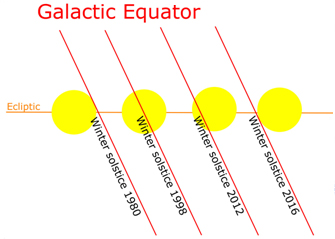 |
|
Winter Solstice Galactic Alignment of the Sun with the Galactic Equator
|
On Earth, the River Nile was the reflection of this great river in the sky, in accordance with the Hermetic principle "as above, so below." Herschel's earliest ingenious research has demonstrated that all of the pyramids along the river Nile represent constellations along the Milky Way, not just Orion! There are more than 50 pyramids in total, and their true meaning can only be deciphered when one considers the whole of Egypt.
During a Great Celestial Conjunction, the Sun crosses that great river in the sky, the Milky Way. Egyptologists explain that the solar God Ra (and Horus) required a boat because they sailed the Heavens from sunrise in the East to sunset in the West. At night, Ra travelled the Netherworld to be reborn in the morning at sunrise. Egyptologists reject the idea that the Egyptians understood the Precession of the Equinoxes and that the Sun also sojourns along the zodiac in a 26,000 year journey corresponding with the Precession Cycle.
In the Book of the Gates, the travel of the Sun at night along with the deceased pharaoh into the Netherworld is described. The Sun enters the Netherworld in the first hour just after sunset to be reborn in the morning at sunrise after a twelve hour nocturnal journey. There are many parallels, however, with the precessional journey of the Sun along the twelve signs of the zodiac to be discovered in the Book of the Gates. The 12 hours in the Book of Gates are structured into four groups of three hours, denoting a cross in the face of the clock. In the 12th hour Nun raises the solar barque with the scarab beetle of the Sun God from the primeval waters (Milky Way?), this is the hour of the rebirth of the Sun.
|
|
Left: Nun raises the solar barque from the primeval waters at ‘sunrise’, the time of the rebirth of the Sun.
|
During Ra's travel through all of the twelve signs of the zodiac in the precession cycle, he will be requiring a boat to twice cross that great river in the sky, the Milky Way! It is probably the only reason why the Egyptian deities required a Sun barque in the first place. Boats are used to cross waters, not skies, so it was used not for their nightly ecliptic travel from East to West through the Netherworld, but for their travels along the zodiac in the precession cycle. It is during this journey that the Sun would be required to cross the waters of the Milky Way at least twice. The Book of the Gates may therefore have been misinterpreted by Egyptologists as the nocturnal journey of the Sun simply because they reject the idea that the Egyptians understood Precession! Keep in mind that only twice per year on the equinox the day and night will be exactly 12 hours in length. It is therefore far more logical that the 12 hours in the Book of the Gates are in fact the 12 zodiacal Ages of the Precession Cycle.
Pharaohs in ancient Egypt were buried with their arms crossed holding Ankhs in their hands. This posture of the deceased pharaoh can be found on sarcophagus and in statues throughout Egypt. The Ankh represents a cross symbol.
|
|
Left: Grave statue of Tjel mayor of Memphis under Amenhotep III Dutch national museum of antiquities, Leiden.
Right: Sarcophagus with crossed arms and X cross on chest, Dutch National Museum of antiquities, Leiden.
|
Since the Greek inherited much of their wisdom from the Egyptians, it's more than reasonable to suspect that the gate or portal mentioned in the Book of the Gates through which the pharaoh enters the Netherworld is, in fact, the Gate of God that the Greek writer Macrobius writes about. The Gate of God was also called the Golden Gate, while the Gate of Men was called the Silver Gate. The very same Egyptian cross symbolism used by the pharaohs associated with the Golden and Silver gates of the soul (and the Sun) can still be recognized in the coat of arms of the Vatican, consisting of two crossed keys; one Golden, one Silver.
|
|
Silver and Golden cross in the Coat of Arms of the Vatican
|
The Golden Gate is the ecliptic Milky Way crossing at the Scorpio-Sagittarius nexus on the zodiac while the Silver Gate is the Milky Way ecliptic crossing at the Gemini-Taurus nexus. The Silver Gate was represented by the horns of Isis and the associated bull Taurus.
The Silver Gate is also clearly depicted in the Narmer Palette (3100 BC) named after the Egyptian pharaoh. The Narmer Palette shows the celestial goddess bull Bat (Taurus) with her horns bent over pointing exactly to the place of the rebirth of the Sun, the Silver Gate. The two cow's heads on top of the palette also represent Bat. In-between the two cow goddesses a hieroglyph is depicted representing the rising of the Sun in between two mountains on the horizon. It's a hieroglyph that is very similar to the Akhet hieroglyph with the same significance.
|
|
Bat on the left and right with the 'Akhet' glyph in between.
Dutch national museum of antiquities, Leiden
|
Bat was the goddess of the Milky Way considered to be a pool of Bat's cow milk. Bat was also the goddess of the human soul, the "Ba" that incarnated into human life form. Since the soul incarnated into human life passing through the Silver Gate (crossing of Milky Way and ecliptic), it's not surprising that Bat was both the goddess of the Milky Way and the human soul. Ba is a derivative of Bat, whereas "Ka" represents the human light-body. "Mer" represents the light of the Egyptian light-body-soul complex, the "Mer-Ka-Ba." Bat was also called the "Ba of Two Faces." Egyptologists are in the dark about her name and don't seem to understand that she was called this way, because there are actually two portals both to and from the Netherworld for the Ba to descend into the physical plane (Silver Gate) and ascend from the physical plane (Golden Gate). Both Hathor, Isis and Bat are all cow goddesses and Egyptologists have often pointed out the similarities between these goddesses depicted with cow-horns suspecting that they may have the same origins...they all represent the Silver Gate.
At the bottom of the Narmar palette in-between the horns of the bull, the very same hieroglyph is depicted as the one shown between two Bat bulls on top of the palette. This Akhet-like hieroglyph symbolises the rising Sun on the horizon.
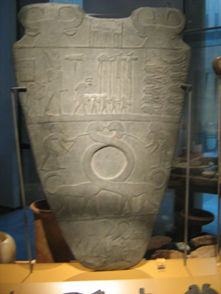 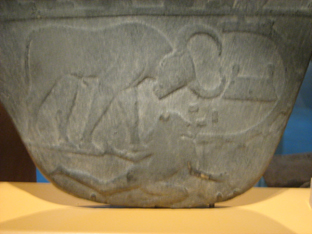 |
The Narmar Palette, bull in close up on the right. The bull is leaning towards the Silver Gate near the Gemini-Taurus nexus depicted in between the horns. The hieroglyph in between the horns resembles an Akhet glyph and represents the Silver Gate.
Dutch national museum of antiquities, Leiden
|
On the other side of the Narmer palette two identical men, hence suggesting twins are depicted. They are both looking over their shoulders to a particular square over the left man’s shoulder. We surmise that the twins represent Gemini which would make sense since the actual ecliptic Milky Way crossing of the Silver Gate occurs in 5° Gemini (sidereal zodiac) and the square could therefore be suggesting the Silver Gate.
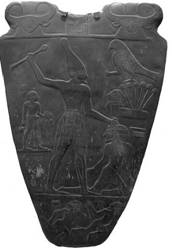 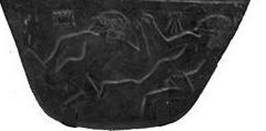
Narmer palette backside
Dutch national museum of antiquities, Leiden
The author Audrey of the website "Ancient Egypt" writes while referring to the Narmar Palette: "They present an overview of the astronomical event which occurred on September 21st in 4468BCE, when the Autumn (Fall) Equinox of the Sun was in conjunction with the Milky Way."
At the Autumnal Equinox, the Sun was indeed at the Milky Way, however at the Golden Gate. At the Vernal Equinox of 4468 BC, the Sun resided at the Silver Gate. The author (Audrey) does not seem to realise that this moment represented a Great Celestial Conjunction when the equinox axis (Vernal and Fall) aligned with the Galactic Equator and the Sun resided at the Gates of the Gods.
Instead, while interpreting the hieroglyphs of the 10 decapitated figures near the Solar Barque, he writes quote, "The full meaning of the hieroglyph can therefore be interpreted as 'the Sun at a sacred gateway, opening or portal'..."
While Hathor, Isis and Bat are all cow goddesses, Egyptologists have often pointed out the similarities between these goddesses depicted with cow-horns suspecting that they may have the same origins. . . .
We suggest that they all represent the Silver Gate.
There is an even older Egyptian goddess that later was associated with Isis and Hathor. Her name is Serket and she was the deification of the scorpion goddess who healed stings and bites. Eventually, Serket was associated with Isis and she was said to be just an aspect of Isis. Serket and Isis can therefore be regarded as the ‘Ba of Two Faces’. While Isis represents the Silver Gate at the Gemini-Taurus nexus, Serket is her counterpart and she represents the Golden Gate at the Scorpio-Sagittarius nexus. This is why she’s wearing the scorpion on her head while she joined Ra in his barque on his journey around the zodiac in a Great Year.
 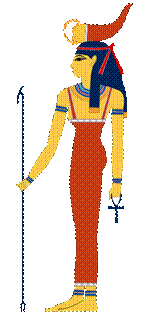
Left: Isis with the solar disk in between the horns representing the Silver Gate
Right: Serket with the scorpion at her head representing the Golden Gate.
The sacred Egyptian scarab beetle is a metaphor for the Sun in the precession cycle whereas the dung ball represents the Sun. The scarab beetle rolls its dung ball with his hind legs backwards, symbolizing the backward motion of the Sun through the zodiac in the precession cycle. Since the scarab beetle has many similarities with a scorpion, we surmise that Serket and the scarab beetle both represent the Golden Gate in Egyptian mythology.
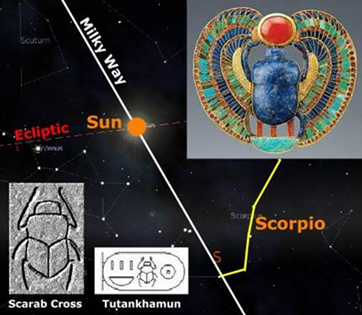
Right: Scarab representing the crossing of the ecliptic and Milky Way
near Sagittarius-Scorpio nexus. The dung ball of Scarab beetle is the Sun.
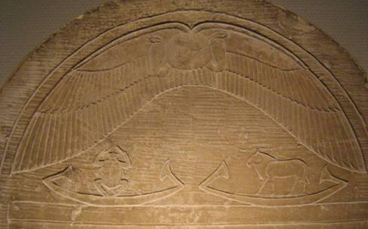
On the left, the scarab beetle in a barque. On the right, the bull with the horns in a barque. They represent the places where Ra requires a barque to cross the Milky Way river in the precession cycle and thus represents the galactic equator.
Dutch national museum of antiquities, Leiden.
The most interesting of female ‘horned’ Egyptian goddesses in the Egyptian pantheon is Seshat. She was the goddess of astrology mathematics architecture and keeper of the measure of time.
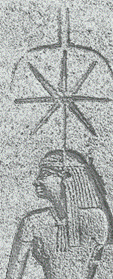
Seshat with the down turned horns and eight pointed cross.
Although interpretations differ what the cross above Seshat represents, some believe it represents a seven pointed star on a pole, other believe it represents a papyrus leaf, the authors of this article suggest that it represents an eight pointed cross, symbol of the Great Celestial Conjunction. It is placed right below the down turned horns exactly at the place where the Sun will reside during a Great Celestial Conjunction at equinoxes or solstices. Seshat headdress was called Safekh-Aubi (Sefekh-Aubi) and meant ‘She who wears the two horns’.
Seshat helped pharaoh with the alignment of the temples in Egypt in a ritual called Pedjeshes which translates into ‘Stretching the cord’ (Pedj--"to stretch," Shes--"a cord"). Armed with two pegs connected by a rope, pharaoh was accompanied by a priestess representing Seshat and aligned the temple to the celestial’s Bull’s leg while Seshat connected the other peg to her ‘home place’.
Since Seshat’s ‘home place’ is in between the horns of bull Taurus where the Sun resides at a Great Celestial conjunction and where also the eight pointed cross is depicted, the authors suggest that in the Pedjeshes alignment ritual the Pleiades as the ‘leg of the bull’ (Taurus) is being used to show the way to the place where the Sun would reside at a Great Celestial Conjunction. In this ritual the temple was aligned accordingly!
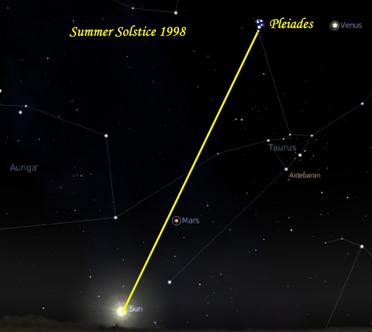 |
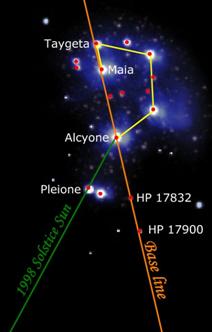 |
Pleiades as a way shower to the summer solstice Sun of 1998 (Great Celestial Conjunction era 2012)
See also Wicherink’s reinterpretation of Herschel’s conclusions on Stonehenge
Wayne Herschel mentions ‘the stretching of the rope’ ritual in his book ‘The Hidden Records’. The ‘Leg of the Bull’ (meaning the Pleiades) is mentioned in the temple of Hathor in Dendera where it is written:
“The living god Thoth – nourished by the sublime goddess in the temple – the sovereign of the country – stretches the rope in joy (align with it) – With his glance .. - ..towards the ‘ak’ of the bull’s thigh constellation.. – he establishes the temple house of the mistress of Dendera, as it took place there before”
(Wayne Herschel, The Hidden Records, pg 141)
http://www.keyofsolomon.org/gatesOfTheSun.php
|
|
|
|
|
|
|
¿INDEPENDENCIA ARGENTINA EN EL VERDADERO PENTECOSTES?
|
|
| Eventos astronómicos |
| Luna nueva |
Jueves 28 Marzo 1816 21.31' |
| Cuarto creciente |
Jueves 7 Marzo 1816 5.1' |
| Luna llena |
Mièrcoles 13 Marzo 1816 21.56' |
| Cuarto menguante |
Mièrcoles 20 Marzo 1816 17.55' |
| Eclipse |
ningún eclipse de sol |
| ningún eclipse de luna |
|
La hora está en T.U. o sea tiempo universal del meridiano de Greenwich; las fases de la luna son aproximadamente con error máximo de 2m; pero en el eclipse de sol la señalización de la zona visible es solamente indicativa.
|
|
|
|
| Eventos astronómicos |
| Luna nueva |
Sàbado 27 Abril 1816 13.28' |
| Cuarto creciente |
Vienes 5 Abril 1816 16.19' |
| Luna llena |
Vienes 12 Abril 1816 6.43' |
| Cuarto menguante |
Vienes 19 Abril 1816 9.42' |
| Eclipse |
ningún eclipse de sol |
| ningún eclipse de luna |
|
La hora está en T.U. o sea tiempo universal del meridiano de Greenwich; las fases de la luna son aproximadamente con error máximo de 2m; pero en el eclipse de sol la señalización de la zona visible es solamente indicativa.
|
|
|
|
| Eventos astronómicos |
| Luna nueva |
Lunes 27 Mayo 1816 3.3' |
| Cuarto creciente |
Sàbado 4 Mayo 1816 23.59' |
| Luna llena |
Sàbado 11 Mayo 1816 15.35' |
| Cuarto menguante |
Domingo 19 Mayo 1816 2.36' |
| Eclipse |
Eclisse anulare di Sole (area antartica)
Lunes 27 Mayo 1816 3.15'
|
| ningún eclipse de luna |
|
La hora está en T.U. o sea tiempo universal del meridiano de Greenwich; las fases de la luna son aproximadamente con error máximo de 2m; pero en el eclipse de sol la señalización de la zona visible es solamente indicativa.
|
|
|
|
| Eventos astronómicos |
| Luna nueva |
Martes 25 Junio 1816 14.10' |
| Cuarto creciente |
Lunes 3 Junio 1816 5.10' |
| Luna llena |
Lunes 10 Junio 1816 1.17' |
| Cuarto menguante |
Lunes 17 Junio 1816 19.53' |
| Eclipse |
ningún eclipse de sol |
| Eclisse totale di Luna
Lunes 10 Junio 1816 1.14'
|
|
La hora está en T.U. o sea tiempo universal del meridiano de Greenwich; las fases de la luna son aproximadamente con error máximo de 2m; pero en el eclipse de sol la señalización de la zona visible es solamente indicativa.
|
|
|
|
| Eventos astronómicos |
| Luna nueva |
Mièrcoles 24 Julio 1816 23.16' |
| Cuarto creciente |
Martes 2 Julio 1816 9.27' |
| Luna llena |
Martes 9 Julio 1816 12.26' |
| Cuarto menguante |
Mièrcoles 17 Julio 1816 12.55' |
| Eclipse |
ningún eclipse de sol |
| ningún eclipse de luna |
|
La hora está en T.U. o sea tiempo universal del meridiano de Greenwich; las fases de la luna son aproximadamente con error máximo de 2m; pero en el eclipse de sol la señalización de la zona visible es solamente indicativa.
|
|
|
|
|
|
 Primer
Primer
 Anterior
2 a 5 de 350
Siguiente
Anterior
2 a 5 de 350
Siguiente Último
Último
|

